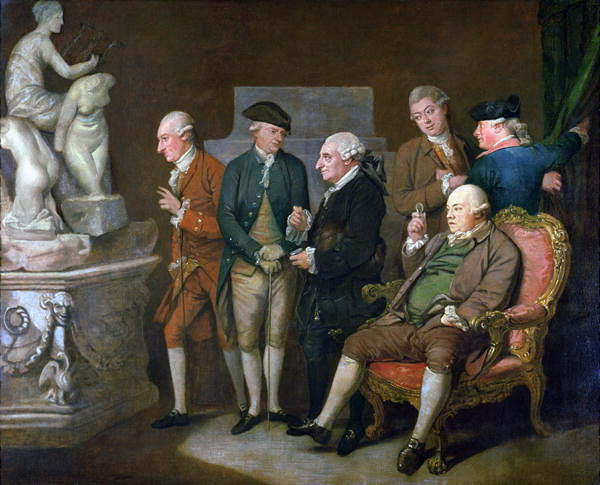
A decade before painting Townley's library, Johan Zoffany had been commissioned by Queen Charlotte to record the masterpieces of Cosmio de' Medici, Grand Duke of Tuscany in another conversation piece, The Tribuna of the Uffizi. Taking his pregnant fourteen-year old wife-to-be, he boarded ship to Florence, where he set up his studio in the octagonal Tribuna, charging aristocrats twenty guineas for the privilege of being included in the picture, and then charging others the same price to take their place. In consequence, there were the portraits of a great many undistinguished English travelers (twenty-two in all) cluttering a room already filled with works introduced from elsewhere in the Uffizi and even the Pitti Palace.
In a letter to Sir Horace Mann (November 12, 1779), Horace Walpole ruefully remarks that the painting is "crowded with a flock of travelling boys, and one does not know nor care whom." Apparently one did, as two well-known homosexuals were included: Horace Mann himself and the painter Thomas Patch, who (in the detail above) is pointing to the naked wrestlers behind him, his other hand on the corner of Titian's Venus of Urbino—which also appears in Zoffany's Self-Portrait with a Friar's Habit (1779), a torn strip from the picture mimicking the two condoms hanging on the wall.
Behind them are another group of men (one with a monocle) gazing admiringly at the backside of the Medici Venus, the sight of which, Townley once had been told, "will give you some yammering after a Tuscan whore." Indeed, the Scottish novelist Tobias Smollett had rhapsodized "Without all doubt, the limbs and proportions of this statue are elegantly formed, and accurately designed, according to the nicest rules of symmetry and proportion; and the back parts especially are executed so happily, as to excite the admiration of the most indifferent spectator." When Zoffany returned to England in 1779, his royal patrons were horrified at the impropriety of the painting and put it out of sight. With no more royal commissions, the artist went to India in 1863 to make his fortune, which he did.

"He who hath a long and great nose is an admirer of the fair sex, and well accomplished for the wars of Venus, but ignorant of the knowledge of anything that is good, extremely addicted to vice; assiduous in the obtaining what he desires, and very secret in the prosecution of it; and though very ignorant, would fain be thought very knowing."
Aristotle's Masterpiece (The Secrets of Nature Relating to Physiognomy, Chap. II)
Charles Townley with a Group of Connoisseurs (c.1771–1775), a conversation piece by Richard Cosway, is a singularly lascivious response to the callipygian Venus. Townley is engaged in conversation with several like-minded friends as they admire two statues of the goddess, one exhibited from the front, the other from the rear. As with the observer in Zoffany's Tribuna, one connoisseur uses his eyeglass to improve the view. But it all is more furtive and voyeuristic than first appears. Townley himself looks away, perhaps in deference to the sitter but the others gaze at the nudes. One need only look more closely to see that their excitement is palpable, as two of the men have their busy hands thrust deep in their pockets.
References: "Johan Zoffany: One to Watch" (Spring 2012), RA: The Royal Academy of Arts Magazine, Issue 114; "Genius Unveiled: The Self-Portraits of Johan Zoffany" (1987) by William L. Pressly, Art Bulletin, 69(1), 88-101; John Zoffany, R. A., His Life and Works, 1735-1810 (1920) by Victoria Manners and George Charles Williamson; Sexuality in Eighteenth-Century Britain (1982) edited by Paul-Gabriel Boucé; Tobias Smollett: Travels through France and Italy (Letter XXVIII, February 5, 1765); Aristotle's Masterpiece (c.1684) was an early manual on sex and pregnancy.